Banff National Park is pretty spectacular any time of year, but there is one season when it becomes just a little extra special! Banff larch season is when you can witness the brief but breathtaking transformation of its alpine larch trees in the fall. This is the best time to get out and explore all the best larch hikes in Banff!
As the temperatures drop and the days grow shorter, the larches, a type of deciduous conifer, prepare for winter by shedding their needles. But before they do, they put on a dazzling display of golden brilliance, turning the alpine landscapes into carpet of yellow. This phenomenon is known as the larch season in Banff, and it’s a spectacle that leaves visitors in awe.

In this guide, we will share the best Banff larch hikes. While unfortunately, it will be harder to find solitude during the Banff larch season, walking through a stand of larch trees at the peak of the transformation will more than make up for it. We’ll share the most iconic and lesser-known larch hikes plus which are the easiest larch hikes in Banff.
This post contains compensated links.
17 Best Larch Hikes in Banff
Here are the best larch hikes in Banff National Park. While many of them are concentrated around the Lake Louise area, there are others in the list that are closer to the town of Banff and have their own parking lot. It’s still important to get to the Banff larch hikes early so you can get a parking spot, especially on weekends.
Read More
This post focuses on the larch hikes in Banff National Park, but there are other incredible larch hikes in the neighbouring parks. Don’t miss our full list of the Best Alberta Larch Hikes.
1. Larch Valley Hike

Larch Valley Hike Stats
Distance: 8.6 km / 5.3 miles out-and-back
Elevation Gain: 535 m / 1755 ft
Difficulty: Moderate
Time Required: 3-4 hours round-trip
The Larch Valley hike, commencing from the stunning Moraine Lake, stands out as the epitome of larch hikes in Banff. However, its popularity isn’t merely a product of its clever name – it’s well-deserved.
The trail to Larch Valley begins with a climb through the forest with little to keep your attention besides moving your feet forward. As the terrain levels off, you’ll be in awe of the transformation around you. You’ll find yourself amongst golden larches with impressive mountain scenery all around.
If you have the time and energy, continue past Larch Valley to the Minnestimma Lakes then on to Sentinel Pass. The incredible mountain vistas are more than worth the effort.

The biggest challenge you’ll have is getting to Moraine Lake. There are no private vehicles allowed on Moraine Lake road. Keep reading as we have all the best options for getting to Moraine Lake to enjoy the best Moraine Lake hikes during Banff larch season below.
We like the Larch Valley to Sentinel Pass hike so much that we’ve included it in our Banff hiking trip itinerary.
Read More
Find out more about this amazing Banff larch hike in our complete guide to Hiking Larch Valley in Banff
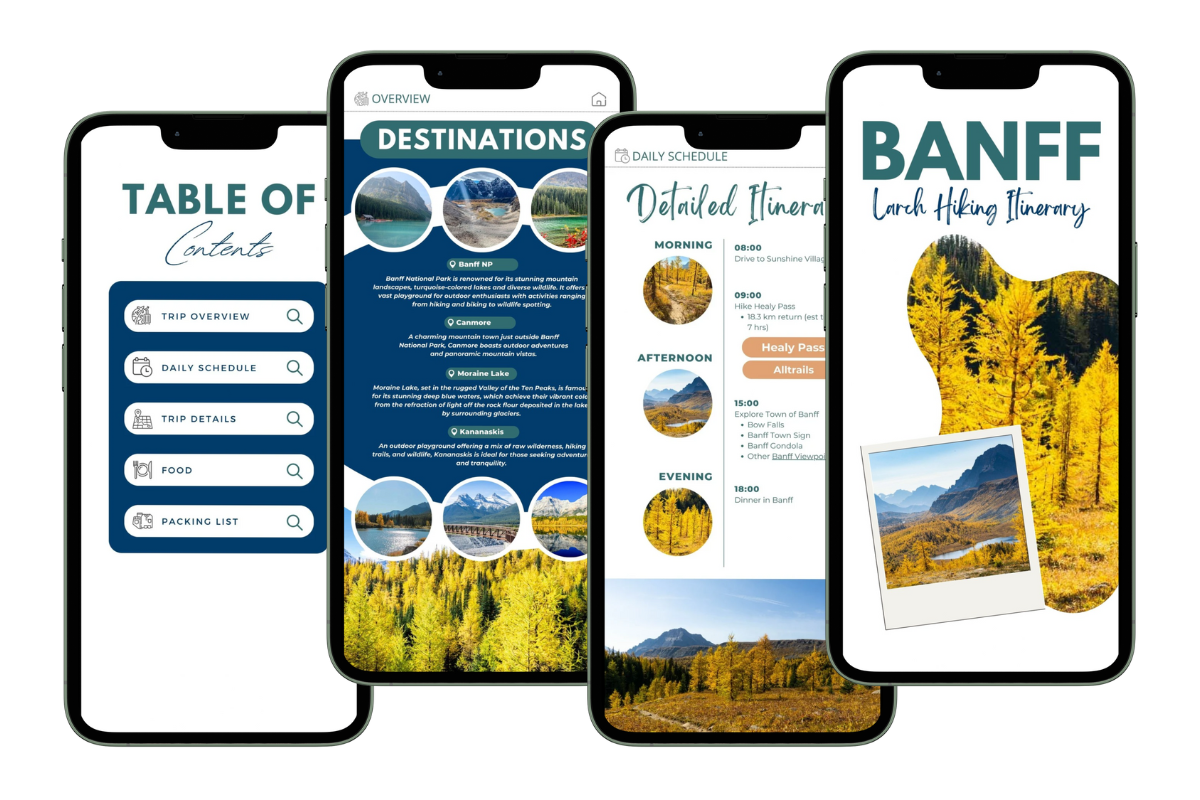
Need Help with Your Banff Itinerary?
Get our 4 Day Banff Larch Hiking Itinerary. In this mobile friendly itinerary, we share our favourite larch hikes in the area, PLUS everything else you need to plan your trip.
2. Eiffel Lake Hike

Eiffel Lake Hike Stats
Distance: 12.2 km / 7.6 miles out-and-back
Elevation Gain: 610 m / 2001 ft
Difficulty: Moderate
Time Required: 3-4 hours round-trip
If your appetite for the golden larch trees at Moraine Lake remains unquenched, then be sure to carve out some time for a visit to Eiffel Lake.
Setting off from the very same trailhead that leads to Larch Valley and Sentinel Pass, your journey will commence with the same series of switchbacks. As you ascend, you’ll eventually reach a junction with a welcoming bench – rest assured, it’s impossible to miss it. Here, you’ll veer off the Larch Valley trail to continue on the Eiffel Lake hiking trail.
Eiffel Lake, though perhaps lacking the same density of larch trees, compensates with its sweeping vistas of the Valley of Ten Peaks and notably fewer crowds. It’s not such an up close view of the larch trees, but instead the magnificent views of a substantial stand of larch trees from a distance that makes this Banff larch hike worthwhile.
Read More
Read our complete guide to Hiking Eiffel Lake in Banff.
3. Wenkchemna Pass Hike

WenkChemna Hike Stats
Distance: 18.3 km / 11.6 miles out-and-back
Elevation Gain: 929 m / 3047 ft
Difficulty: Moderate to Difficult
Time Required: 4-6 hours round-trip
For those seeking an extended adventure, consider pushing your hike beyond Eiffel Lake and onward to Wenkchemna Pass, where an even greater abundance of larches awaits. This extension adds an additional 6 kilometres to your journey, resulting in a round-trip distance of 18.3 kilometres from the trailhead.
It’s worth noting that as you progress along the Wenkchemna Pass trail, the density of larches gradually thins out, and eventually, you’ll encounter smaller trees in the alpine meadow. Nevertheless, the vista from Wenkchemna Pass, which looks down upon Eiffel Lake surrounded by its golden larches, is nothing short of spectacular.

The trail maintains a moderate level of ease until you approach the last 500 meters or so leading up to the pass, where the terrain becomes steeper and the path grows slightly more challenging to navigate. Yet, the rewards at the summit, offering breathtaking views on both sides of the pass, make every step well worth the effort.
Read More
Wenkchemna Pass is one of our favorite hikes in the Moraine Lake area. Get all the details you need in our post on Hiking Wenkchemna Pass in Banff.
4. Saddleback Pass Hike

Saddleback Hike Stats
Distance: 7.4 km / 4.6 miles out-and-back
Elevation Gain: 595 m / 1952 ft
Difficulty: Moderate (note: Parks Canada rates this hike as ‘difficult’, but it’s not that bad)
Time Required: 2-3 hours round-trip
While Saddleback Pass might not boast the same level of fame as the Banff Larch Valley hike at Moraine Lake, it stands as one of the best larch hikes at Lake Louise, offering an exceptional alternative to the more popular Larch Valley.
Embarking on the Saddleback Pass hike, you’ll commence your journey near the picturesque shores of Lake Louise, in close proximity to Chateau Lake Louise. This trailhead ranks among the most beautiful you’ll encounter anywhere in the world.
As you ascend, you’ll traverse a conifer forest for approximately 2 kilometres along the northern slopes of Fairview Mountain, which stands proudly at 2,744 meters. The magic unfolds when you first come upon the first golden larches.

Over the next 2 kilometres on this larch hike in Lake Louise, prepare to be in awe as you traverse a magnificent forest of golden larches, all the way to Saddleback Pass. The sheer density of larch trees along this Lake Louise hike is incredible.
Parking will fill up quickly at Lake Louise, so it’s best to get there very early or plan your Lake Louise shuttle. We share more details below on the best ways to get to Lake Louise during larch season.
Read More
Learn more about Hiking Saddleback Pass in Banff, including many of the add-on hikes you can also enjoy.
5. Sheol Valley Hike

Sheol Valley Hike Stats
Distance: 14.7 km / 9.1 miles round trip
Elevation Gain: 884 m / 2900 ft
Difficulty: Moderate (it’s long, but not that difficult)
Time Required: 4-5 hours round-trip
While the Saddleback Pass hike undoubtedly offers breathtaking views of larch trees, the one drawback worth mentioning is the crowds. Saddleback Pass is a highly sought-after alternative to Larch Valley, and this popularity can make capturing those larch images a bit challenging due to the presence of your fellow hikers.
Our recommendation is that once you’ve reached Saddleback Pass, extend your journey further into the serene Sheol Valley, where you can revel in the beauty of larch trees without the crowds.
Of course, as with most things in life, there’s a trade-off. While you’ll savor the tranquility of the Sheol Valley along with its abundant larch trees, you’ll need to cover an additional 11 kilometres to circle around Saddle Mountain and return to Chateau Lake Louise.
The Sheol Valley landscape is nothing short of epic, and the majority of the hiking terrain is either downhill or level, making it a less daunting prospect than it might initially seem.
Read More
Read our complete guide to Hiking Sheol Valley to Paradise Valley in Banff.
6. Big Beehive Hike

Big Beehive Hike Stats
Distance: 11.4 km / 7.1 miles loop
Elevation Gain: 520 m / 1706 ft
Difficulty: Moderate
Time Required: 3-4 hours round-trip
The Big Beehive hike at Lake Louise may not always be featured among the top larch hikes, due to its relatively lower larch tree density compared to more renowned trails like Larch Valley. However, it is still a worthwhile larch hike with incredible views.
You’ll start with the hike to Lake Agnes tea house. The scenery around Lake Agnes is stunning and you’ll find the shores dotted with golden larches.
After you’ve hiked through the larch trees along the shores of Lake Agnes and along the switchbacks leading up to the Big Beehive, you’ll find a large stand of larch trees awaits at the Big Beehive Lookout.
Add to this the view of Lake Agnes PLUS Lake Louise down below and you’ll see why this hike is more than worth it.
Read More
The Big Beehive trail is one of our favorite hikes in Banff and we try to do it every year. We share everything you need to know in our post on the Big Beehive Hike in Banff.
7. Hidden Lake Hike

Hidden Lake Hike Stats
Distance: 18 km / 11.2 miles out-and-back (6km along fire road)
Elevation Gain: 670 m / 2198 ft
Difficulty: Moderate
Time Required: 5-6 hours round-trip
If you’re in search of a less crowded larch hike in Banff, the Hidden Lake trail is an excellent choice.
Setting off from the Skoki parking lot near the Lake Louise Ski Resort, the Hidden Lake hike unfortunately kicks off with an initial 3 kilometres along a service road, which may not be the most thrilling part of your journey. The only option to avoid this is to join one of the Parks Canada guided hikes that will take you up the road on a shuttle.
From the end of the road section, the Hidden Lake hike is 5.2 kilometres each way and is characterized by its relatively easy terrain. Along this trail, you’ll have the pleasure of witnessing larch trees embracing the shores of Hidden Lake, all while enjoying a splendid vista of larches adorning the Skoki Valley.

Although there are other remarkable larch hikes in the vicinity, this one stands out for its accessibility to most hikers.
Other choices for hikes in this region include Boulder Pass which is around 17 km return and 645 m elevation Gain, or the Skoki Lakes where you’ll be looking at over 25 km to do this in a day.
Read More
Read our complete guide to Hiking Hidden Lake in Banff.
Lake Louise may be home to all the mega-popular larch tree hikes in Banff, but it doesn’t have a complete monopoly on them. There are several excellent Banff larch tree hikes elsewhere in the park.
8. Healy Pass Larch Hike
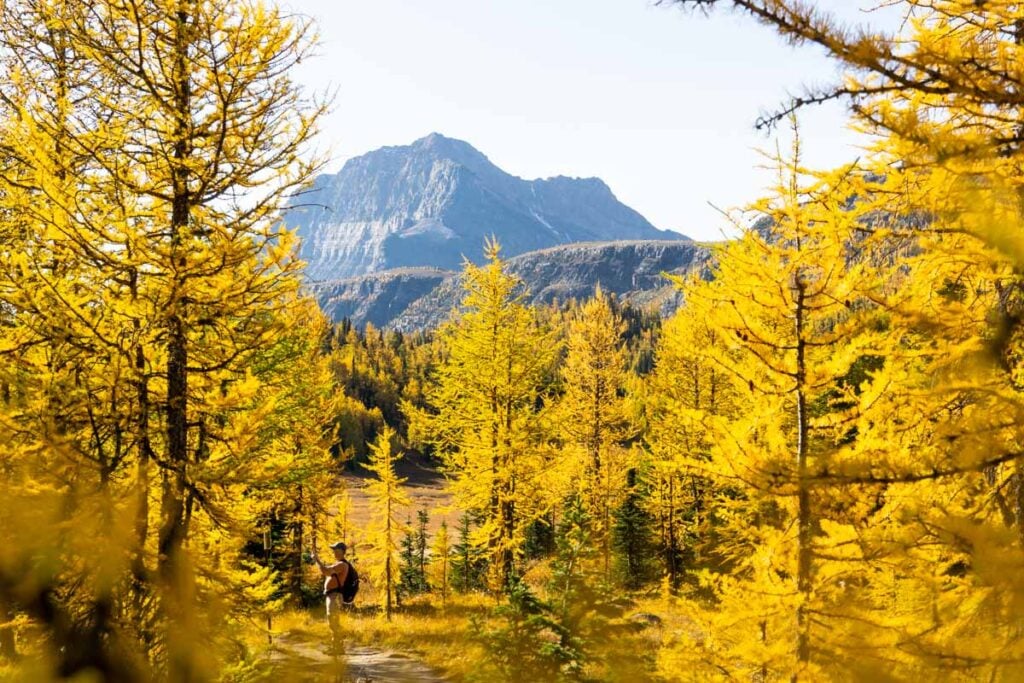
Healy Pass Hike Stats
Distance: 18.3 km / 11.4 miles out-and-back
Elevation Gain: 890 m / 2920 ft
Difficulty: Moderate
Time Required: 5-7 hours round-trip
When it comes to Banff’s larch hikes that can rival the renowned Larch Valley, Healy Pass emerges as the best contender. In fact, the Healy Pass Trail has quickly claimed a spot as our favourite larch hike in Banff.
The journey to Healy Pass commences with approximately 7.4 kilometres of winding through the forest. While some may describe this initial stretch as boring, we encourage you to savor the fall colors throughout this section, even if they aren’t the sought-after larches.
The incline is gentle throughout, so as long as you can handle the distance, you’ll find this larch hike to be a wonderful hiking adventure.
Around the 8.5-kilometre mark, you’ll enter a meadow where larch trees envelop you. This hike not only grants you ample time within the larch forest but also treats you to breathtaking vistas of larches scattered across the valley as you ascend toward Healy Pass.

Upon reaching Healy Pass itself, the larch trees continue to captivate. They adorn the slope on the opposite side, providing the perfect backdrop for a leisurely lunch while you soak in the scenery.
An additional perk of the Healy Pass hike is the beginning of the descent, where those mountain vistas illuminated by the golden glow of larches will be constantly in view.
One other benefit of this larch hike in Banff is that it sets off from the Sunshine Village parking lot – where there’s plenty of parking!
Read More
The Healy Pass hike is one of our favorite larch tree hikes in Banff National Park. Get all the details in our post on hiking Healy Pass.
9. Taylor Lake Larch Hike

Taylor Lake Hike Stats
Distance: 16 km / 10 miles out-and-back (including hike to meadow)
Elevation Gain: 1,035 m / 3396 ft
Difficulty: Moderate (it’s long, but not that difficult)
Time Required: 4-5 hours round-trip
There are few sights that can rival the beauty of a larch forest in the fall in Banff, but if there’s one thing that comes close, it’s the breathtaking view of golden larches casting their reflections upon the tranquil waters of a mountain lake nestled high in the Rocky Mountains.
The journey to Taylor Lake offers a highly enjoyable stroll through a lush evergreen forest, rich with non-larch trees. While the scenery along the first part of the path to Taylor Lake lacks mountain scenery, we have always enjoyed the hike through the forest.
It won’t be long before you’re taking in Taylor Lake nestled within a picturesque mountain cirque. With the majestic Rocky Mountains as its backdrop, Taylor Lake is beautiful any time of year but especially in the peak larch season in Banff. On a calm day, the mirror-like reflection of these larch trees in the lake’s waters is nothing short of extraordinary.

But hold on, because there’s more to this experience! Venture to the rear of the Taylor Lake campground, and you’ll discover a sign marking the trailhead for the Panorama Ridge hike.
This short hike extension has some steep sections, but the rewards are worth it. Before long, you’ll find yourself immersed in a forest of golden larches, complete with a charming mountain stream meandering through. Don’t miss out on this brief extension to your Taylor Lake hike.
Read More
Read our complete guide to Hiking Taylor Lake in Banff.
10. O’Brien Lake

O’Brien Lake Hike Stats
Distance: 18.8 km / 11.7 miles out-and-back
Elevation Gain: 1,155 m / 3789 ft
Difficulty: Moderate
Time Required: 4-5 hours round-trip
The first 75% of the O’Brien Lake hike is along the same hiking trail as the very popular Taylor Lake hike.
In the fall, you’ll enjoy more fall colors than just golden larch trees. The brightly coloured bushes that line the hiking trail showcase their bright red and yellow leaves. We especially like the red fireweed leaves in fall, as they glow brightly in the sun.
As you reach the meadow you’ll find the trail junction to O’Brien Lake. Taylor Lake is so close, you should really take a few moments and go take a look, before returning to complete the Lake O’Brien hike.
The O’Brien Lake trail runs through lush woods with spruce and fir trees and moss and tiny shrubs for a carpet.
You’ll enter a meadow with scattered larch trees and evergreens. The trail through the meadow can get extremely muddy, and you can virtually count on your hiking boots getting dirty. The golden larch trees get more dense as you approach O’Brien Lake. The first glimpse of O’Brien Lake caused our daughter to literally stop in her tracks and say “Wow!”.

Lake O’Brien was mirror-like resting peacefully at the foot of Mount Bell with golden larches reflecting perfectly in the perfectly still water. There are much fewer people at Lake O’Brien, guaranteeing a more peaceful lake experience than Taylor lake.
Read More
O’Brien Lake is a lesser known hike in Banff. Be sure to read our complete guide to Hiking O’Brien Lake in Banff before heading out.
11. Arnica Lake

Arnica Lake Hike Stats
Distance: 9.3 km / 5.8 miles out-and-back
Elevation Gain: 758 m / 2487 ft
Difficulty: Moderate
Time Required: 3-4 hours round-trip
The Arnica Lake hike offers not one, but two pristine Banff lakes to grace your journey. Commencing from the Vista Lake parking lot, the trail to Arnica Lake begins with a descent that leads you to the captivating Vista Lake.
Here, the emerald-green waters of Vista Lake glisten under the sunlight, while the golden larches adorning the shoulder of Storm Mountain making this a stunning fall hike in Banff.
It won’t be long after Vista lake where you’ll start to climb, with plenty of roots and rocks to make sure you’re lifting your feet! Yet, as the trail becomes more demanding, the vistas become increasingly spectacular as you get closer to the radiant golden larches adorning Storm Mountain.

The captivating scenery alone is reason enough to recommend the Arnica Lake trail as a an excellent choice for larch hiking in Banff. But there are two more spots along this trail that you don’t want to miss. The first is the stunning Arnica Lake, nestled at the base of Storm Mountain, with its far shores decorated by larch trees, creating a picturesque scene.
The second spot awaits beyond Arnica Lake, along the hiking trail leading to the Twin Lakes. Even if you climb only to the meadow’s summit, you’ll find yourself surrounded by larches, with views of more in the distance. While this larch forest may not be as densely packed as the one in Larch Valley, the effort is unquestionably worth it

For an extension to Arnica Lake, continue to hike to Twin Lakes. While you won’t be treated to much more for larches, you’ll complete the hike having seen four mountain lakes. If you want to add to the larches you see, then you’ll need to continue on to Gibbon Pass.
The total distance round-trip to Twin Lakes 16.6 km, while the hike to Gibbon Pass is over 21 km.
Read More
The Arnica Lake trail is a breathtaking hike in Banff in any season. Don’t miss our guide to Hiking Arnica Lake in Banff.
12. Sunshine Meadows

We’ve enjoyed hiking at Sunshine Meadows several times over the years. While it’s best known as one of the best Banff hikes for wildflowers, for anyone up for an adventure it can also be an incredible Banff larch hike.
Since the Sunshine Gondola stops operating in early September, the only option is to walk or bike up the 5 km to Sunshine Village. Again, the Standish Chair will no longer be operating, so you’ll need to lock up your bike and continue on foot.
Take the Rock Isle Road up to Rock Isle Lake Viewpoint (1.8 km / 1.1 miles). From there continue on to the Rock Isle Junction then turn towards the Grizzly / Laryx Junction. The best larch hiking will be along the Grizzly / Laryx loop (3.6 km / 2.2 miles).
You can go back the way you came along Rock Isle Road back to the village.
If you want to get that iconic Sunshine Meadows view from the Standish Viewing Deck, from the Rock Isle Junction climb the 0.7 km (0.4 miles) to the viewing deck.

Another option is to continue from the Standish View Deck back down to the Twin Cairns Junction then hike to Monarch Lookout. This will add another 2.2 km / 1.4 miles then an additional 1.8 km / 1.1 miles to the village. The larches will be small and stunted along this alpine meadow, but the views are still beautiful!
Here are the distances for the different hiking trails at Sunshine Meadows options:
- Sunshine Village to Rock Isle Junction and Grizzly Laryx Loop Return Trip – 7.2 km / 4.5 miles (+ 10 km / 6.2 miles on access road)
- Sunshine Village to Rock Isle Junction, Grizzly / Laryx Loop & Standish Viewing Deck Return Trip – 8.6km / 5.3 miles (+ 10 km / 6.2 miles on access road)
- Sunshine Village to Rock Isle Junction, Grizzy / Laryx Loop, Standish Viewing Deck, Twin Cairns to Monarch Lookout to Village – 11 km / 6.8 miles (+ 10 km / 6.2 miles on access road)
Read More
Without question, Sunshine Meadows is one of the most beautiful hiking areas in Banff. Learn all about it in our Guide to Sunshine Meadows in Banff.
13. Bourgeau Lake Trail

Bourgeau Lake Hike Stats
Distance: 13.8 km / 8.6 miles out-and-back
Elevation Gain: 910 m / 2986 ft
Difficulty: Moderate
Time Required: 4-6 hours round-trip
If you are looking for a moderate-to-challenging larch tree hike near the Town of Banff, check out the Bourgeau Lake Trail. The larch forest growing near Bourgeau Lake is not as plentiful as some of the other hikes on this list, but the larches make a nice compliment to the other highlights along this hike.
On your way up to the lake, you’ll pass one of the most impressive waterfalls in Banff National Park. The waterfall alone would make the hike worth it, but the larch trees and scenic alpine setting for Bourgeau Lake are icing on the cake.
Read More
Learn more about this scenic Banff hike in our post about the Bourgeau Lake Trail.
14. Lake Annette Hike

Lake Annette Hike Stats
Distance: 11.4 km / 7.1 miles out-and-back
Elevation Gain: 370 m / 1200 ft
Difficulty: Moderate
Time Required: 3-4 hours round-trip
If you love larch trees in fall, but hate the crowds which often accompany them, check out the larch trees at Lake Annette. The hike to Lake Annette is along the Paradise Valley Trail, which is often overlooked these days, now that Moraine Lake Road is closed to public vehicles.
But, if you make the effort, the larch scenery around Lake Annette is stunning. Lake Annette sits at the base of Mt. Temple, the 3rd tallest mountain in Banff National Park. With Mt. Temple looming directly overhead, there’s a larch stand of larch trees along the lakeshore and the lower slopes of the mountain. All this fall scenery and very few people… a great combination!
Read More
It’s a bit tricky getting to the trailhead. Get all the information you need in our full blog post on the Paradise Valley Trail to Lake Annette.
15. Lake Louise Ski Resort Larch Hikes
To eliminate the majority of the elevation, you can take the Lake Louise Summer Gondola and enjoy two hikes to view the larch trees. Many of the hikes in Lake Louise and Banff to see larch trees involve long days and a lot of kilometres. Given the help of the Lake Louise Gondola, you’ll find these to be easy larch hikes in Banff (not easy to find) and great larch hikes to do with kids.
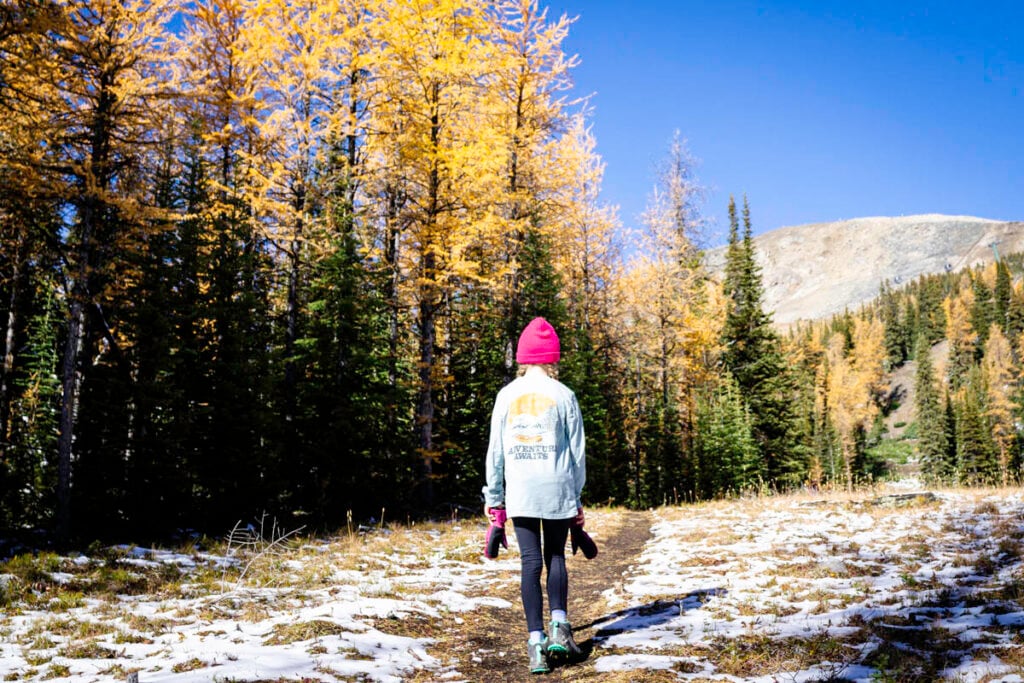
The two hikes you can do from the top of the Lake Louise gondola are Kicking Horse Pass Viewpoint at 1.7 km / 1.1 miles round trip or the Pika Trail to the Ptarmigan Valley Viewpoint at 3.4 km / 2.1 miles round trip.
The Kicking Horse Pass Viewpoint starts along a gravel road. It has a small section through the trees that opens up to rock boulders that have larch trees around.
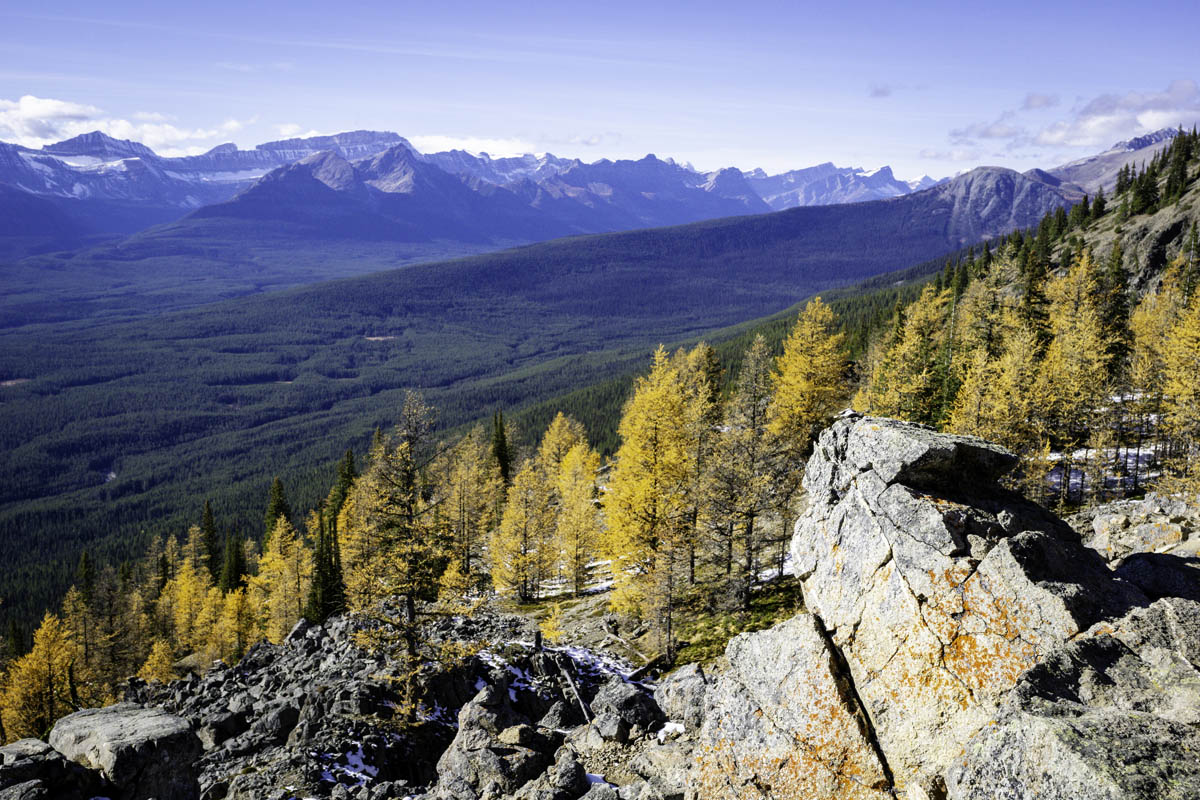
The better trail is the Pika Trail, which actually has you walking through a stand of larch trees.
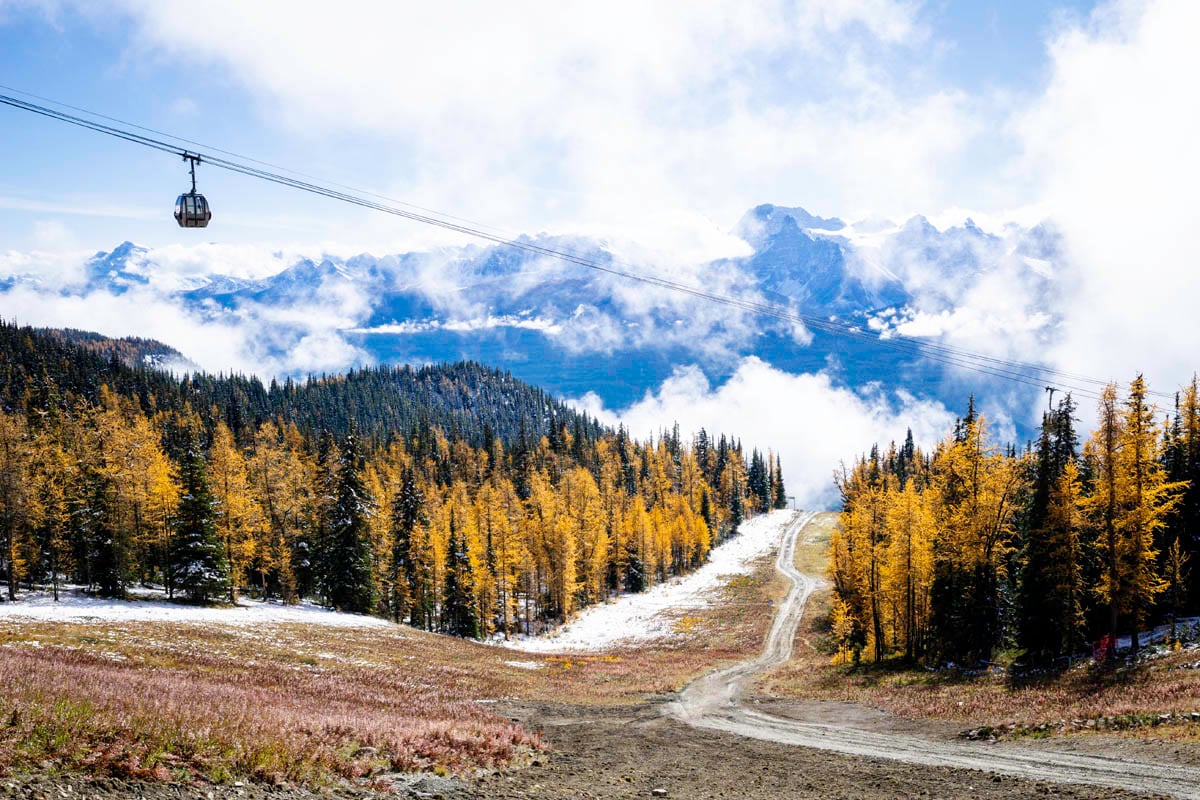
I recommend you continue up to the Ptarmigan Valley Viewpoint, which allows you to look down on the larch forest you just walked through and you get to look down the valley on the other side which is covered in larch trees.
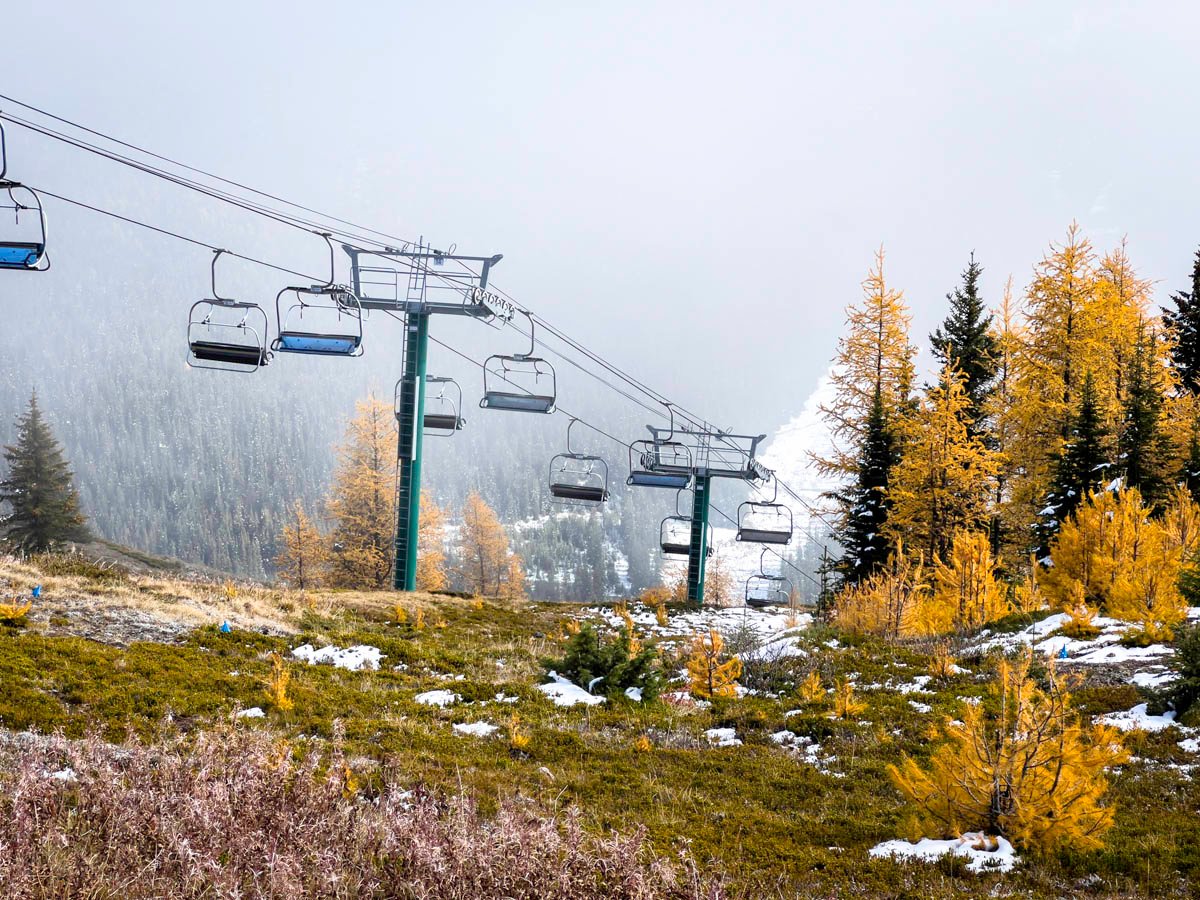
Read More
The summer gondola at Lake Louise is one of the top attractions in Banff. Learn more in our guide to the Lake Louise Summer Gondola.

16. Plain of the Six Glaciers

Plain of 6 Hike Stats
Distance: 14.6 km / 9.1 miles out-and-back
Elevation Gain: 558 m / 1831 ft
Difficulty: Moderate
Time Required: 3.5-5 hours round-trip
While Lake Louise boasts some of Alberta’s most exceptional larch hikes, it’s worth noting that the Plain of Six Glaciers hike doesn’t quite fit that description. However, once we set aside our expectations for a dense larch forest, we can fully appreciate the Plain of Six Glaciers for what it truly is—a standout hiking experience in Banff. We love the Plain of Six Glaciers hike and believe it is an excellent fall hike in Banff.

This trail offers an incredibly scenic journey, featuring the renowned Plain of Six Glaciers Tea House as one of its highlights. While the larch trees may not dominate the landscape, there is a modest cluster of them just beyond the Six Glaciers Tea House, adding a touch of larch beauty to this remarkable hike.
Read More
The Plain of Six Glaciers hike is a must-do hike in Banff National Park. Be sure to read our Complete Guide to Hiking Plain of Six Glaciers in Banff.
17. Little Beehive

Little Beehive Hike Stats
Distance: 8.8 km / 5.5 miles out-and-back
Elevation Gain: 490 m / 1608 ft
Difficulty: Moderate
Time Required: 3-4 hours round-trip
Again, while the Little Beehive Hike might not claim the coveted top spot on any “best larch hike in Lake Louise” lists, it does offer a scattering of these beautiful trees along its path.
For a more substantial larch experience, consider venturing to the nearby Big Beehive hike or combining it with the Plain of Six Glaciers hike to create an epic hiking adventure. The mountain vistas and panoramic views overlooking Lake Louise will certainly compensate for the relatively sparse presence of larch trees along the way.

Read More
Read our Complete Guide to Hiking Little Beehive in Banff.
For even more larch hikes near Banff, we recommend reading our post on the Best Kananaskis Larch Hikes or our guide to Lake O’Hara hiking trails in Yoho National Park.
How to Get to the Best Banff Larch Hikes
Banff Larch Hikes
If you’ve rented a car for your fall visit to Banff, then that’s the only way to get to these best larches hikes: Healy Pass, Taylor Lake, Sunshine Meadows, O’Brien Lake and Arnica Lake.
For the Lake Louise Ski Resort hikes and Skoki Valley (Hidden Lake, Boulder Pass, Skoki Lakes) hikes, you have only a few options:
1. Drive to the Lake Louise Ski Resort. For the Skoki Valley hikes, you’ll turn off before the Ski Resort towards Fish Creek parking lot and park there.
2. If you are staying in Lake Louise, catch the Parks Canada Park & Ride Connector for free to get from the Lake Louise Village to the Lake Louise Ski Resort. For the Skoki Valley hikes, you’ll need to walk from the Ski Resort (adding another 1.5 km).
3. Hop On Banff – The Hop On Banff bus leaves from Banff and will go to Lake Louise Ski Resort.

Lake Louise Larch Hikes
For any of the hikes at Lake Louise, you’ll need to either get to the parking lot very early or try one of these options:
1. Stay at a Nearby Hotel – Stay at a hotel close enough to walk to the trailhead like Paradise Lodge & Bungalows or right at the lakeshore at the Fairmont Chateau Lake Louise.
2. Parks Canada Shuttle – Book a Parks Canada Lake Louise Shuttle. If you don’t have a car, you’ll still need to get yourself to the Lake Louise Ski Resort from Banff.
3. Roam Transit – Take Roam Route 8S/8X from Banff to Lake Louise lakeshore.
4. Moraine Lake Bus Company – The Moraine Lake Bus company offers shuttle rides to Lake Louise. Just choose a departure time that will allow enough time for your hike.
5. Via Via Moraine – The Via Moraine Lake Shuttle Service is an excellent way to get from Banff or Canmore to either Lake Louise or Moraine Lake. Their daytime shuttle will give you enough time to get a good hike in.
6. Fairview Limo – Fairview Limo provides transportation from the village of Lake Louise to Lake Louise. Choose a return time late enough to allow you to hike. You still need to get yourself to the village of Lake Louise.
7. Hop On Banff – The Hop On Banff bus leaves from Banff and you can choose departure and return times that will allow you to hike at either Moraine Lake or Lake Louise
8. WowBanff – WowBanff leaves from the Lake Louise Ski Resort and you can choose a return time late enough that you can fit in a hike.

Moraine Lake Larch Hikes
Moraine Lake can no longer be reached by private vehicle, so there’s no longer concerns about Moraine Lake Parking.
There are several ways to get to Moraine Lake, but all involve booking a shuttle or a tour. We highly recommend you read our post on Getting to Moraine Lake, but if you are short on time this is a summary of the best options that will give you some time for the best hikes at Moraine Lake:
1. Stay at Moraine Lake – While expensive, staying at the Moraine Lake Lodge will give you all the time you want at this spectacular Banff lake.
2. Parks Canada Shuttle – Book a Parks Canada Lake Louise Shuttle for only $8 per adult. If you don’t have a car, you’ll still need to get yourself to the Lake Louise Ski Resort from Banff.
3. Roam Transit – In September only, Roam transit operates Route 10 that goes directly from Banff to Moraine Lake. Or take Route 8X/8S to Lake Louise (with a Reservable System Wide Day Pass) and take the Parks Canada Lake Connector Shuttle from Lake Louise to Moraine Lake.
4. Moraine Lake Bus Company – The Moraine Lake Bus company offers shuttle rides that will get you to Moraine Lake for sunrise or later. Just choose a departure time that will allow enough time for your hike. You’ll need to get yourself to the Lake Louise Ski Resort to park.
5. Via Via Moraine – The Via Moraine Lake Shuttle Service is an excellent way to get from Banff or Canmore to either Lake Louise or Moraine Lake. Their daytime shuttle will give you enough time to get a good hike in.
6. Fairview Limo – Fairview Limo provides transportation from the village of Lake Louise to Moraine Lake. Choose a return time late enough to allow you to hike. You still need to get yourself to the village of Lake Louise.
7. Guided Hike – Explore Banff Tours & Transfers has a guided hike option for Larch Valley.
7. Hop On Banff – The Hop On Banff bus leaves from Banff and you can choose departure and return times that will allow you to hike at either Moraine Lake or Lake Louise
8. WowBanff – WowBanff leaves from the Lake Louise Ski Resort and you can choose a return time late enough that you can fit in a hike.

For all other Banff larch hikes, we recommend arriving at the parking lot before 9am if possible, especially on weekends.

Need Help with Your Banff Itinerary?
Get our 4 Day Banff Larch Hiking Itinerary. In this mobile friendly itinerary, we share our favourite larch hikes in the area, PLUS everything else you need to plan your trip.
Other Tips for Banff Larch Hikes
Before you head out on your hiking adventures to immerse yourself amongst the Banff larch trees, here are some additional tips to prepare you for long hiking days in Banff:
1. Have a plan for your larch hikes in Banff
It’s best to plan out your larch hikes. Once you know which ones you want to do, plan to do the most popular ones during the week and leave the lesser known ones for the weekend.
2. Check trail reports before doing any Banff larch hikes
Trails can be closed due to bears or require groups of 4 or more. Always check trail conditions before heading out.
3. Cheat and get a hotel room
A fun and easy way to enjoy golden larches without the super-early wake-up call is to eliminate the long drive and stay at a hotel close to the larch trees.
4. Dress appropriately
Dressing for a day of hiking in the Canadian Rockies can be tricky, even in the heart of summer. Given larch tree season is between mid-September and early October, dressing appropriately is even harder.
Chances are that you will be starting your day early enough to get a parking spot. The sun is lower in the sky this time of year and will often be hiding behind mountain peaks. You may not get direct sunshine until mid-morning (if at all). No sunshine equals significantly colder temperatures.
Also, keep in mind that the temperature drops 1C for every 150m of altitude gain. Given the high-altitude larch trees grow in, the temperature on your larch tree hike will be several degrees colder than the forecasted temperature for Calgary, Banff or Canmore.
Even if the forecast is for 20C+, bring a warm jacket, gloves and a toque. Trust us – you’ll be glad you did.

5. Bring appropriate hiking gear
In addition to bringing multiple layers of warm clothing, make sure you have all the appropriate hiking gear with you. Most of these are long day hikes in Banff, so you’ll want proper footwear (hiking boots or shoes), a day bag (to carry water, snacks & layers), and warm layers for those passes and when the weather changes. You may also need proper winter traction devices such as micro spikes and trekking poles if your larch hike recently received a snowfall.
Read More
Before hitting the trails, check our our post on Banff hiking essentials for our recommended fall hiking gear in Banff.
6. Get an early start
A lot of these hikes are long and will take the majority of your day. Get an early start to ensure you get parking and to avoid needing to hike late in the day or the dark.
7. Be bear aware
Travel in groups the bears are busy trying to fatten up for the winter. Bear spray is a must. What’s better is if you can hike in groups of 4 or more.
Wildlife Safety
When hiking in Banff National Park, you are responsible for your own safety. Before hitting the hiking trails we highly recommend you read our Essential Banff Hiking Tips for information about bear safety, trail conditions, wildlife warnings and possible closures.
8. Pack plenty of food and water
September can still get quite warm and these hikes are at higher elevations. Bring plenty of food, snacks and more water than you think you will need.
Learn About Banff Larch Trees
What do Larch Trees Look Like?
In the summer Banff larch trees are full of green needles, making them difficult for a casual observer to distinguish a larch tree from other conifer trees. Starting in mid-September, larch trees become much easier to identify as the needles on a larch trees turn a beautiful golden color, while the other boring conifers stay green.

How do you Identify a Larch Tree?
The easiest way to identify a larch tree is to wait until fall and watch for their needles to change to their famous golden color.
If you’d like to identify a larch tree when their needles are not golden, the easiest way is to look at their needles. Larch trees in Alberta have little nipple-like bases protruding from their branches. From each of these nipples, a larch tree will grow up to 40 needles.
When is Larch Season in Banff?
For those visiting Banff in September, you are in luck! The Banff larch season typically starts around mid-September until early October. The needles on larch trees start to change color every year in mid-September. When they first change, the larch trees look lime-green, but before long they are ablaze with a full body of bright golden needles.

A great way to monitor when the larches start changing color in Banff is to check out the hashtag #larchvalley on Instagram.
How Long do Larches Stay Yellow?
The answer to this question varies every year, but typically they start dropping their needles in early October. You can still enjoy Banff larch hikes if you are visiting Banff in October, but the golden needles become more sparse as the month progresses.

Where do Larch Trees Grow in Banff?
Subalpine larch trees grow at elevations of 1,800 to 2,400m above sea level (5,900 to 7,900 ft). This is a significantly higher than the elevation of Banff (1,383m), Canmore (1,309m) and Calgary (1,045).
Where are Larches in Lake Louise?
Lake Louise is one of the best spots in Banff to see golden larches in fall. The elevation of Lake Louise is 1,600m, with surrounding mountain peaks ranging in elevation from 2,500m to 3,400m. These are ideal conditions for the Subapline larch tree to thrive.
The best stands of larch trees in Lake Louise can be found on hikes around Larch Valley, Saddleback Pass and the hikes around Lake Agnes.

Where to See Larches in Banff?
The best area to view larch trees in Banff is the Lake Louise / Moraine Lake area. But the popularity of viewing larch trees around Lake Louise means that getting a parking spot is often difficult.
Some good alternatives to Lake Louise larch tree hikes are Taylor Lake, Arnica Lake and Healy Pass.
Where is Larch Valley?
The extremely popular Banff Larch Valley hike is located at Moraine Lake, near Lake Louise in Banff National Park.

What Species of Larch Trees Grow in Banff?
The most common larch tree you will see in the larch hikes listed above is the Subalpine larch tree (also known as Lyall’s larch). Its Latin name is Larix lyallii.
Please Support Human Created Content
This post was written by a local who lives just minutes outside Banff National Park. If this post was helpful, and you value getting accurate Banff advice from a real human (not AI), please click here to make a small donation or explore other easy ways support our small business. Every bit makes a difference.
Found this post useful? Save it or share it with your friends!
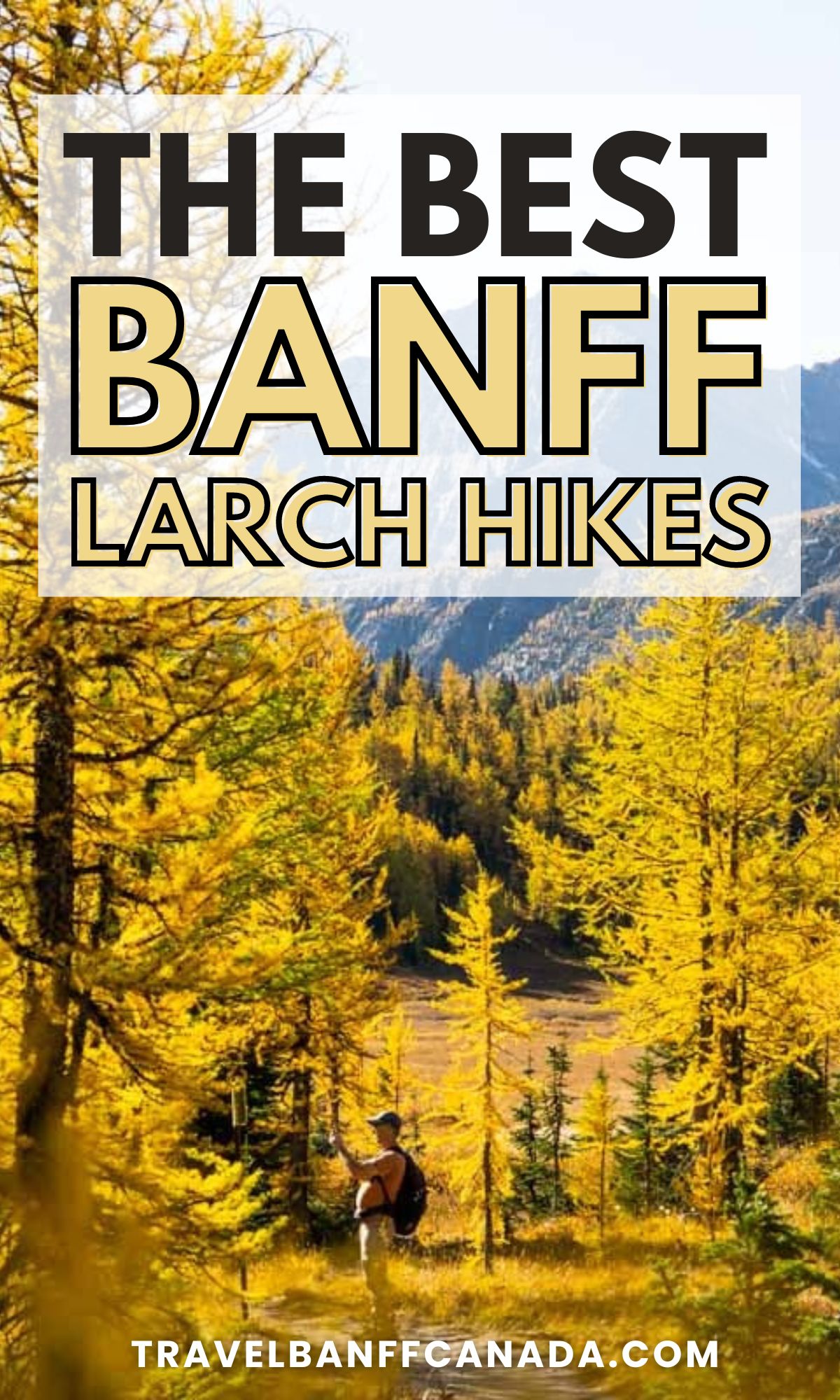
Celine Brewer, a local Canmore resident, is the co-owner of Travel Banff Canada. She has a passion for being out in the mountains any time of year. In the summer, you'll often find her hiking or mountain biking. In the winter, she enjoys cross-country skiing, snowshoeing and winter hiking the most.
As much as she loves the mountains, she also loves travel! When she's not playing outdoors at home, she's either traveling the world with her husband and two kids or working on their other two travel sites: Family Can Travel and Baby Can Travel.

